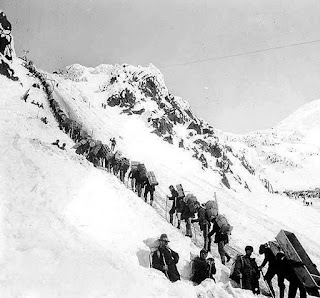This first installment of the blog is essentially the start-to-finish story, leaving the challenges, economics and cast of incredible characters to later posts. That's
all well and good, but it left me with a difficult task of titling the blog. "Klondike: Part 1 - The Whole Story"? That didn't really make sense. As a result I changed it to the title you see currently, and cognizant of the importance I put on the number two of my thought processes I wanted to make sure I used the word "foray" properly. I feel like I lucked out because I thought it meant just to wander into someplace (that's why I double-check these things). Instead... "a sudden attack or incursion into enemy territory, especially to obtain something; a raid."
 |
| Climbing a mountain with all your worldly possessions in the bitter cold with only a vague promise of riches. Back in the old days, that was called a "can't-miss". |
Lucky me. That's perfect.
That's what the Klondike was. The entire rush was an expedition of mayhem that had the same wildness as a haphazard smash-and-grab robbery. The "enemy territory" is really the unforgiving geography itself. We're talking incredible cold, no true roads to get there, and a lack of supplies upon arrival. True north strong and brutal. Lastly, let's not forget that a "raid" is no prolonged venture. The entire run of the Klondike gold rush lasted only three years, an miniscule length of time considering its incredible significance. What's funny is how many people went out to hunt for gold in those three years considering it wasn't any great secret - except for maybe just how much gold there was. After all, the Russians knew about it for half a century.
 |
| Some of the adventurers really planned ahead. The guy at the bottom right is already carrying up his casket. |
In 1834 the Ruskies discovered the large amounts of gold in and around the Yukon and Alaska, but back then it wasn't all that important. The real money was to be made in the exceedingly lucrative fur trade, and gold just wasn't worth the trouble. As you know, the territory ain't Russian anymore since they sold off Alaska 30 years later. People started trickling into the Yukon and Alaska to mine for gold but with nowhere near the same significance. Reports of great sums of gold were being sent back but to mostly deaf ears; proof was a little trickier back then and word of mouth didn't really spread like it could have.
What changed all of that was in August of 1896 when the first land claim on Bonanza Creek, a tributary of the Klondike, was made. An incredible fortune of gold was found there, and the proof was the prize they returned with. The newly rich brought back their gold on two treasure ships, which came into port in Seattle and proved once and for all that this was indeed the great new get-rich-quick scheme.
It's difficult to express just how crazy people went for this. Everyone wanted a piece, and the news spread around North America like wildfire. Just look at the actions of the mayor of Seattle during this period. He heard the news while visiting San Francisco and was so enamored with the idea of going north to fortune, he didn't even bother to return to Seattle - he sent his resignation letter from there. From just ten days of the arrival of the treasure boats, already 1,500 had set off for the north. The fervor was not just limited to North America, either. A worldwide phenomenon, one million people laid plans. Of course, just the same way two people that haven't seen each other in a while say "oh yeah, let's definitely hang out," only 10% of those actually did. But still - 100,000 moving on a wing and a prayer is stunning.
 |
| A heart-breaking picture of the fallen horses, of which there were thousands, along the trail to the Klondike. It's also the topic of a rather jarring Yosemite Sam-based Bugs Bunny episode. |
The sudden burst of people is partly due to the press. It was billed as this easy route to guaranteed fame and fortune, a little jaunt over to a place you need a winter jacket, a touch of elbow grease (that good ol' fashion gumption) and you'll be swimming in gold. Instead, the boats setting out were manned by unscrupulous people that crammed it so full of men, women, children and animals that the sea-bound voyages were uncomfortable, repulsive trips. Land routes were no better, arguably worse. Starvation and death were common travellers on the road, and those that gave everything to go only to find out they had no chance of making it would carve warnings into the trees. Many would take their own lives, poor, destitute, and hopeless. Hundreds and hundreds of dead horses littered the trails, as with difficult mass migrations animals rarely escape the death toll. But still they kept coming, back home flooding the news with stories of success, exacerbated by the fact that yes, indeed, a few did find incredible riches.
It's quite the story. Let me sum it up for those of you that just look at the pictures and check the last few lines.
A man claims there's a vast fortune hidden far away. A varied group of people go for a hunt of the treasure only to be hamstrung by a number of setbacks. Most lose everything in the process.
Do you know what I just told you? Two things, both the same. One is, as I said, a summary for the Klondike Gold Rush. The second? The plot to It's a Mad, Mad, Mad, Mad World.
No comments:
Post a Comment